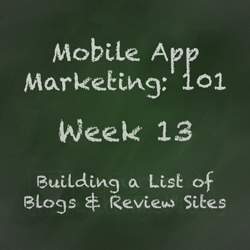Some of the most successful mobile apps found their audience through word-of-mouth, in part due to coverage from reviewers, bloggers, and app directories. In this week’s blog, we’ll talk about how to build a list of sites that may be able to help you get the word out about your app.
From the mundane “Get Your Family to Download Your App” to the off the wall “Create Beer Coasters” join us on a 52-week journey of some of the top ways to promote and market your mobile application.
Week 13
Compiling Review Sites For Pitching Your App
 The first step is searching “[platform name] review sites” on the search engine of your choice. This will inevitably result in a seemingly endless list of potential sites for pitches. Although it’s tempting to try and send a preview of your app to each one, the truth is that it’s best to focus on pitching to the sites that you believe will be most receptive to your product. These could be tech blogs (like Mashable and TechCrunch), tech news sites, industry publications, or broader media outlets.
The first step is searching “[platform name] review sites” on the search engine of your choice. This will inevitably result in a seemingly endless list of potential sites for pitches. Although it’s tempting to try and send a preview of your app to each one, the truth is that it’s best to focus on pitching to the sites that you believe will be most receptive to your product. These could be tech blogs (like Mashable and TechCrunch), tech news sites, industry publications, or broader media outlets.
Once you have accumulated a list of more general review sites for you app’s platform, it’s time to start finding the more niche sites that can give your app greater visibility. It’s essential to remember that apps are not just used by the tech community; indeed, I’d say that the majority of app users do not actively follow what’s up-and-coming in terms of mobile apps.
It’s worthwhile to consider the non-tech communities that might be interested in your app. What hobbies or interests could your app appeal to? Think about your own pastimes and passions – how could your app make them easier or more enjoyable? With that in mind, you might find that you have a new audience that could benefit from learning about your app project.
What Sites Do I Pitch To?
There are numerous different review sites for each major mobile platform. In the case of iOS and Android, there are literally thousands of different blogs and sites dedicated to reviewing and covering the latest in apps for their respective devices. Some are more general, while others focus on a particular niche (games, productivity, fitness, etc.). With that in mind, it’s important to take a careful look at each site before considering it for a pitch. For starters, you might try sites like 148 Apps, Android Police, App Safari, and Android Tapp.
Some review sites aren’t as reputable as you may need; others may be well-established but difficult to contact. In some situations, a reviewer may ask for payment before they’ll even consider your app for review. In any case, it’s essential that you keep in mind what you’re ultimately hoping to achieve by pitching your app to these review sites. Is it installs, or are you just trying to drum up some pre-release hype for an app that’s still in beta testing?
Of course, the ultimate key to pitching your app is emphasizing what makes it unique. In that vein, next week we’ll take a look at how to highlight your app’s features and benefits.
As always, follow us on Twitter and Facebook to keep up.
The 52 Week Series of Marketing Mobile Applications
Week 1: Talk to Friends & Family
Week 2: Picking the Right Name for Your App
Week 3: App Store Optimization
Week 4: Submitting Your App to Review Sites, Blogs, and Directories
Week 5: Using Video to Promote Your App
Week 6: Creating a Microsite
Week 7: Creating a Press Kit
Week 8: Creating a Marketing Plan
Week 9: Social Media: Facebook
Week 10: Social Media: Twitter
Week 11: Social Media: Other Platforms
Week 12: Social Media: Managing Your Social Media Presence
Week 13: Social Media: Reaching out to Bloggers & Reviewers
Week 14: Finding What Makes Your App Unique






